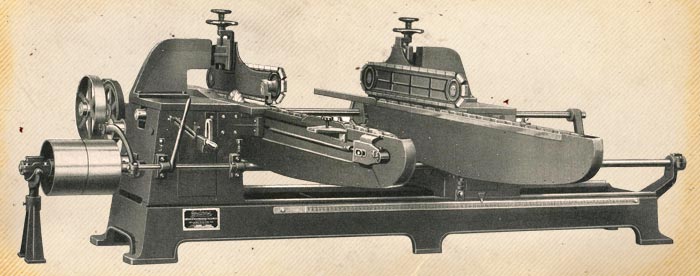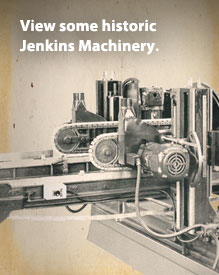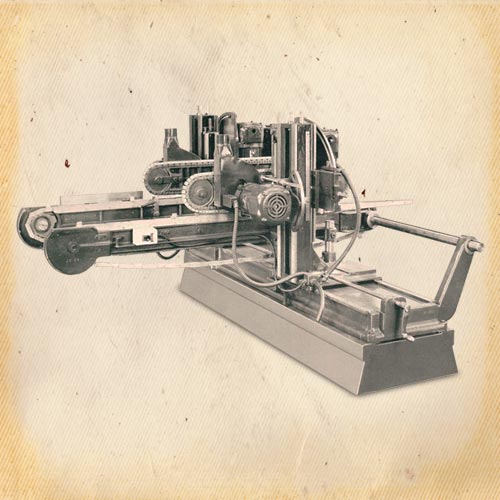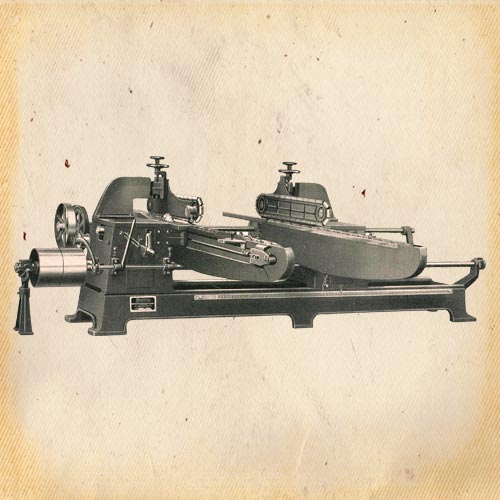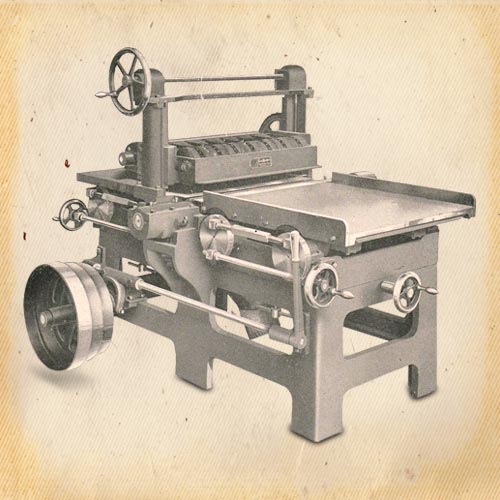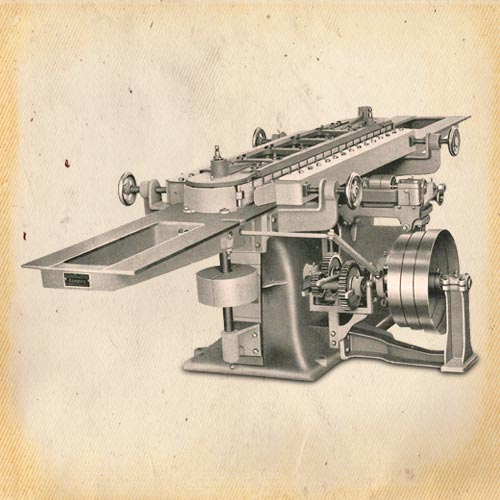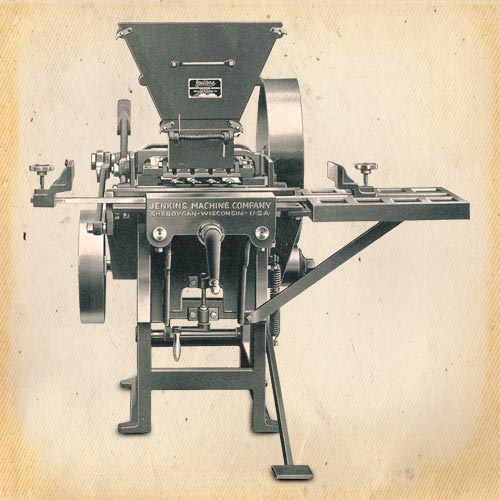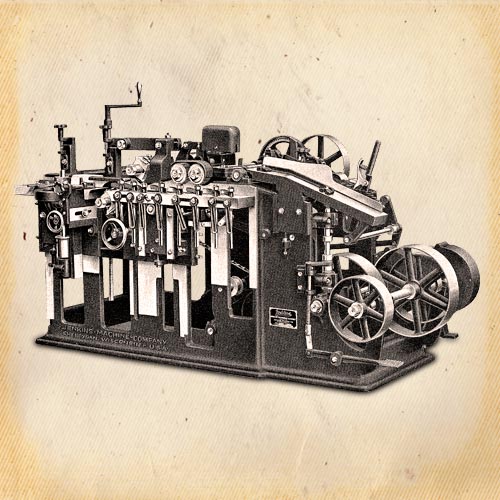Jenkins Machinery Company was founded on the corner of 8th Street and Jefferson in Sheboygan, Wisconsin. The company operated a machine shop and foundry specializing in general machining and the manufacture of chair irons (used for making office chairs). In 1916 three companies were combined to produce Jenkins Machine Company: Jenkins Machinery Company, Falls Machine Company, and E.B. Hayes Machine Company. The combination of these companies included a woodworking line encompassing straight line rip saws, continuous feed glue joiners, glue clamps, planers, double-end tenoners (DET), double end trim and cut-off saws, 3-in-1 machines, stile borers, dowel machines, and related sash and door machinery.
Jenkins Hayes No. 85 Double End Tenoner
The Jenkins Hayes No. 85 Double End Tenoner was a double geared tenoner. The design of the double geared tenoner originated with the E.B. Hayes Company and was improved by Jenkins. The original machine used babbitt (poured) bearings. Jenkins eventually changed to ball bearings. Each cylinder head arbor, saw arbor and cope arbor were driven with an independent high-speed induction motor, eliminating the use of all belts - adding to the improvements in the later models of this machine.
Jenkins Relocates to Sheboygan Falls
In 1926, the plant moved from Sheboygan to Sheboygan Falls, Wisconsin. Jenkins continued manufacturing its woodworking equipment redesigning various models for direct motor operation. The most popular models were the Jenkins Model 95 Double End Tenoner and the Model 105 Double End Trim and Cutoff Saw.
Jenkins Acquisitions
Jenkins Machine Company was acquired by Curt G. Joa, Inc in 1935. The product line evolved with the introduction of wide-based machines such as the Jenkins 190 series. The advent of World War II curtailed the manufacture of any products, except for military products. In 1957, Curt G. Joa sold the Jenkins product line and the factory to the Carl J. Kohler family. The Jenkins Machinery Co operated as a subsidiary or the Kohler General Corporation until 2004, when the Kohler General Corporation was dissolved. The machine shop was sold and the Jenkins Systems LLC operation was moved to Sheboygan.
Product Line Expanded
Jenkins Machine product line was expanded to include door sizers, panel cutting lines, multiple-head slatbed machines, and feed through boring machines. The 140 series was an early innovation of the DET, introducing an economical, high rail, dual center traverse machine. With over 500 of the 140 series DET’s having been built, it continues to be one of the durable and most popular machines in the history of Jenkins machinery. This also makes it an excellent candidate for rebuilding and reconfiguring.
CNC Integration
In 1984, Jenkins integrated CNC to the DET, with the presentation of a low cost, multi-axis, auto-setup machine. Since then, Jenkins has been an innovator of cutting edge technology for the DET, constantly improving accuracy, ease of operation, and capacity.
Cutting Machine Advancements
In addition to advancing the design of the DET, Jenkins has been innovative in streamlining and automating CNC Shapers. The introduction of CNC Shapers began in the early 1990’s utilizing a single spindle machine, which is still used today. In 1998, Jenkins introduced the next level of shapers - a Dual Spindle CNC Shaper, which provides exceptional cut quality and further minimizes the sanding and finishing. In addition to this machine, the 3100 series Single End Tenoner, can produce high volumes of parts utilizing feed through shaping and sanding.
Jenkins Relocation to Sheboygan
In 2001, the plant moved from Sheboygan Falls to Sheboygan. Jenkins continued its commitment to innovation with the introduction of the 4200 series Double End Tenoner. This compact DET was specifically designed for the cabinet industry. Jenkins commitment to the future continued with the introduction of the 5100 series CNC Feed-Thru Shape and Sand Machine in 2005. This machine utilizes proven technology, a precision feed chain and a structurally solid design. Exclusive True Blend contouring reduces sanding and improves product finish.
Jenkins Reinvents the DET
Jenkins continued its commitment to innovation with the introduction of the 4200 series Double End Tenoner. This compact DET was specifically designed for the cabinet industry. The machine features a compact footprint, getting the parts to get from infeed to outfeed of the machine in the shortest amount of time, allowing the machine to traverse to the next width size. This machine is also the first to feature a new style of automatic pop-up dog with center spacings configurable through the operator interface, and popped up at the idler sprocket, so the dogs are instantly available for feeding product.
Jenkins Reinvents the SET
Jenkins commitment to the future continued in 2005 with the introduction of a specialized SET, the 5100 series CNC Feed-Thru Shape and Sand Machine. This machine utilizes a structurally solid design along with a precision feed chain and drive system to accurately convey product. Exclusive True Blend contouring reduces sanding and improves product finish by accurately measuring parts and calculating the complex geometric motions on the fly for each part.
Miter Machines Introduced
Jenkins introduced their newest innovations in 2006, the DSMM, Dual Sided Miter Machine, and the SSMM, Single Sided Miter Machine. The DSMM machines both ends of the product accurately sizing each piece. An automated loading and referencing system provides repeatability and precision. The blind mortise and tenon joint is fully customizable and controlled with a simple graphical touchscreen interface. The SSMM machines the product one end at a time, with features similar to the DSMM.
Alaark Acquired Jenkins Systems
In 2008, Jenkins Systems was acquired by Alaark Tooling & Automation, a local machine shop and machine builder. The company was renamed Jenkins Systems & Service LLC. With machining capabilities such as CNC Milling, Boring, Wire EDM, Turning and Welding, Alaark makes almost every Jenkins machine part that cannot be purchased from vendor stock. Combining with Alaark gives Jenkins additional assembly and engineering manpower when it is required. This acquisition has been one of many advantages to the daily operations of Jenkins Systems & Service.
Dual Spindle Door Machine Gets Maintenance Access
In 2009 Jenkins engineering redesigned the highly popular Dual Spindle Door Machine, moving the X-axis from the rear of the frame to middle of the frame. The rear of the machine became guarding and panels, and also now features an interlocked door. The X-axis, Z-axes and spindles can now be accessed by walking in through the rear of the machine. This accessibility makes maintenance and upkeep of the machine much quicker and easier. This feature can be seen here.
Jenkins Today
Jenkins Systems & Service continues to provide our customers with new equipment, rebuilds, and retrofits. Our dedicated support team fulfills all replacement part orders and can service all Jenkins machinery. Inquire within about our field service and troubleshooting capabilities.
As Jenkins moves forward, we will continue to provide innovative solutions to meet the needs of our customers. We have a forward vision based on our solid heritage.

